Longitudinal and transverse flat feet
A full range of orthopedic services, from diagnosis to full recovery
The foot of a person is subject to quite large loads. In the process of evolution, it has acquired a form that allows you to evenly distribute the load of body weight.The bones of the foot are connected by a joint capsule, strong interosseous ligaments, forming its arches and providing a cushioning function when walking and running. Normally, the adult foot rests on three points – the heel bump, the head of the first and fifth metatarsal bones.
The pivot point of the foot:
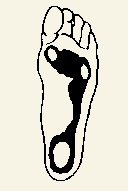
When walking, the foot increases in length by 1.5 cm and expands to 1.7 cm. The weight of the human body is of great importance: the greater the weight, the greater the load on all parts of the foot and, accordingly, the more pronounced flat feet. Flat feet are 20 times more common in women than in men, which is associated with wearing high-heeled shoes, shoes that squeeze the front part of the foot.
Flat feet are understood as static deformities of the foot, accompanied by a decrease (flattening) of its physiological arches.
There are transverse and longitudinal arches of the foot, formed by a system of three arches: internal (1), front (2) and external (3). Longitudinal and transverse arches of the foot:
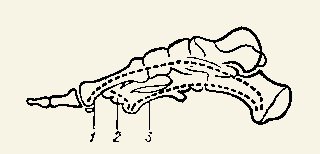

Accordingly, there are transverse (flattening in width) and longitudinal flat feet (flattening in length), as well as a combination of both forms.
Static deformations are changes in the architectonics of the foot, changes in the position of the foot in different planes, followed by a violation of its main functions. Actually, diseases of the feet are often caused by their static changes.
The most characteristic static deformations:
As soon as it becomes difficult to walk, a person tries to get rid of calluses. But this measure of relief, as a rule, does not bring. In place of the removed ones, new corns quickly form, often more painful. Meanwhile, the flatfoot progresses: the head of the first metatarsal bone protrudes inward, it forms a homozolosity, the thumb deviates outward. It is not easy to achieve effective treatment results in such cases.
Normal on radiographs in a straight line projection with a load of 1 the metatarsophalangeal angle (the angle between the axis 1 metatarsal and the axis of the proximal palagi 1 finger) should not exceed 15, and 1 Besplatniy angle (the angle between axis 1 and 2 metatarsal bone) should be less than 8, the distal articular metatarsal angle to 10.
That is why when the initial signs of flattening of the foot appear, you should definitely contact an orthopedic surgeon. First of all, he will recommend choosing shoes for the foot, in which you can put arch supports—special insoles that support the natural height of the arches of the foot— or buy orthopedic shoes.
The formation and growth of corns can be prevented only if it is possible to eliminate the pressure of shoes on the corn: on the insole, according to the place and size of the corn, cut a hole or apply hollow circles cut out of felt or felt to the area of the corn.
Conservative treatment of transverse plastostopia includes: special gymnastics, the wearing of individual orthopedic arch supports (insoles), for women-the restriction of wearing model shoes with high heels.
You can strengthen the musculoskeletal system with the help of therapeutic gymnastics, but only if you do it daily, systematically.
Special exercises are best done in the morning, until the muscles are tired. Repeat each exercise 10-12 times. Breathing, except for exercises 17 and 20, is arbitrary. During the day, it is useful to walk on your toes, on the outer edges of your feet, and for young people to run and jump.
A set of exercises from flat feet:
Sitting on a chair
1. I. P.-feet on the width of the foot. To bend and extend the toes.
2. I. P.— the same to bend and extend the feet (photo 1).
3. I. P.— the same. Lean alternately on the outer edge of one or the other foot.
4. I. P.— the same. Raise and lower the thumb of one or the other foot (photo 2).
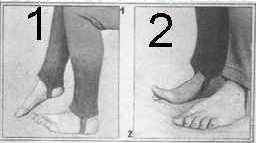
5. I. P.-socks together, heels apart. Alternately raise the feet (photo 3).
6. I. P.— the same. With the fingers and the front part of the sole of one foot, slide from the bottom up on the front-inner surface of the lower leg of the other foot (photo 4). The same - with the other leg.
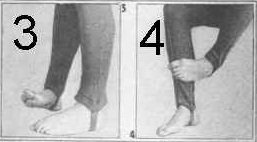
7. Repeat the exercise 6 taking pre-fingers sliding foot piece of cloth (photo 5).
8. I. p.— in exercise 5. Without lifting your feet from the floor, to keep and breed socks, heels remain in place.
9. I. P.-stops nearby. Flexing your fingers, rest them on the floor (photo 6).
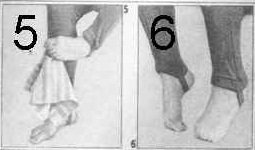
10. I. P.-lean on the ball with one foot. Roll it in a circular motion. The same with the other foot. 11. I. P.-hold the ball with the inner edges of the feet. Lifting one foot up, and the other, lowering down, roll the ball.
12. I. P.-as in exercise 1. Put a long piece of cloth at the feet and move it with your toes towards the heels.
13. I. P.— the same. Grab the buttons scattered on the floor with the fingers of one foot, then the other. 14. I. P.-step on the rolling pin with both feet. Roll it back and forth.
Standing
15. I. P.-feet on the width of the foot. Go up and down on your toes.
16. I. p.— The same. Reduce and dilute the socks, the heels remain in place.
17. I. p.— feet together, arms along the body. Sit down to the maximum-hands forward-exhale; stand up, hands along the trunk-inhale. 18. I. P.-feet on the width of the foot. Walking on the spot, stepping on the rolling pin lying on the floor with the middle part of one or the other foot.
19. I. p.— standing on a piece of fabric. Collect the fabric with the toes to the middle of the foot (photo 7).
20. And p. - standing on a rolling pin. Perform exercise 17 (photo 8).
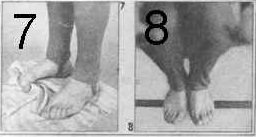
21. I. P.-feet on the width of the foot. Stand on the bar with the front part of the foot and fingers. The same with the other foot (photo 9).
Sitting on a mat on the floor
22. IP-legs bent at the knees. Spreading the knees and pressing them to the floor, connect the feet (photo 10).
The pivot point of the foot:

When walking, the foot increases in length by 1.5 cm and expands to 1.7 cm. The weight of the human body is of great importance: the greater the weight, the greater the load on all parts of the foot and, accordingly, the more pronounced flat feet. Flat feet are 20 times more common in women than in men, which is associated with wearing high-heeled shoes, shoes that squeeze the front part of the foot.
Flat feet are understood as static deformities of the foot, accompanied by a decrease (flattening) of its physiological arches.
There are transverse and longitudinal arches of the foot, formed by a system of three arches: internal (1), front (2) and external (3). Longitudinal and transverse arches of the foot:


Accordingly, there are transverse (flattening in width) and longitudinal flat feet (flattening in length), as well as a combination of both forms.
Static deformations are changes in the architectonics of the foot, changes in the position of the foot in different planes, followed by a violation of its main functions. Actually, diseases of the feet are often caused by their static changes.
The most characteristic static deformations:
- longitudinal flatness – flattening of the internal longitudinal arch of the foot without deviation from the vertical axis and signs of changes in the transverse arch. A decrease in the height of the longitudinal arch is found in almost all age groups;
- plano-valgus feet – flattening of the longitudinal arch with an increase in the load on the inner edge of the foot and displacement relative to the vertical axis inside. The most common deformity of childhood. In adulthood leads to osteoarthritis peritalar joints, curvature of the 1st finger;
- blokowanie foot – flattening of the longitudinal arch of increasing load on the outer edge of the foot and offset relative to the vertical axis outwards. Occur exclusively in adults;
- hollow feet – a sharp increase in the height of the longitudinal arch without deviation from the vertical axis. They occur mainly in women. Hollow feet – a risk factor for the development of heel spurs or transverse flat feet;
- halovalgus feet-an increase in the height of the longitudinal arch with a deviation from the vertical axis inside. This deformity often develops in children during a growth spurt, leading to the formation of secondary longitudinal flat feet;
- polovarus feet – an increase in the height of the longitudinal arch with a deviation from the vertical axis to the outside, a shift in the load on the outer edge of the foot. The deformity develops in both women and men with a high longitudinal arch. Often polovarus feet are formed on the background of paresis of the peroneal nerve in connection with a stroke, sciatica, etc.;
- transverse flatness of the feet – a fan-shaped divergence of the metatarsal bones, accompanied by an increase in the transverse size of the foot. Flatness of the anterior part can occur during pregnancy, against the background of changes in the hormonal background, as a result of inadequate physical activity, in children-due to fibrotic dysplasia. Transverse spreading is both an independent form of static deformation and a symptom found in other types of static changes.
As soon as it becomes difficult to walk, a person tries to get rid of calluses. But this measure of relief, as a rule, does not bring. In place of the removed ones, new corns quickly form, often more painful. Meanwhile, the flatfoot progresses: the head of the first metatarsal bone protrudes inward, it forms a homozolosity, the thumb deviates outward. It is not easy to achieve effective treatment results in such cases.
Normal on radiographs in a straight line projection with a load of 1 the metatarsophalangeal angle (the angle between the axis 1 metatarsal and the axis of the proximal palagi 1 finger) should not exceed 15, and 1 Besplatniy angle (the angle between axis 1 and 2 metatarsal bone) should be less than 8, the distal articular metatarsal angle to 10.
That is why when the initial signs of flattening of the foot appear, you should definitely contact an orthopedic surgeon. First of all, he will recommend choosing shoes for the foot, in which you can put arch supports—special insoles that support the natural height of the arches of the foot— or buy orthopedic shoes.
The formation and growth of corns can be prevented only if it is possible to eliminate the pressure of shoes on the corn: on the insole, according to the place and size of the corn, cut a hole or apply hollow circles cut out of felt or felt to the area of the corn.
Conservative treatment of transverse plastostopia includes: special gymnastics, the wearing of individual orthopedic arch supports (insoles), for women-the restriction of wearing model shoes with high heels.
You can strengthen the musculoskeletal system with the help of therapeutic gymnastics, but only if you do it daily, systematically.
Special exercises are best done in the morning, until the muscles are tired. Repeat each exercise 10-12 times. Breathing, except for exercises 17 and 20, is arbitrary. During the day, it is useful to walk on your toes, on the outer edges of your feet, and for young people to run and jump.
A set of exercises from flat feet:
Sitting on a chair
1. I. P.-feet on the width of the foot. To bend and extend the toes.
2. I. P.— the same to bend and extend the feet (photo 1).
3. I. P.— the same. Lean alternately on the outer edge of one or the other foot.
4. I. P.— the same. Raise and lower the thumb of one or the other foot (photo 2).

5. I. P.-socks together, heels apart. Alternately raise the feet (photo 3).
6. I. P.— the same. With the fingers and the front part of the sole of one foot, slide from the bottom up on the front-inner surface of the lower leg of the other foot (photo 4). The same - with the other leg.

7. Repeat the exercise 6 taking pre-fingers sliding foot piece of cloth (photo 5).
8. I. p.— in exercise 5. Without lifting your feet from the floor, to keep and breed socks, heels remain in place.
9. I. P.-stops nearby. Flexing your fingers, rest them on the floor (photo 6).

10. I. P.-lean on the ball with one foot. Roll it in a circular motion. The same with the other foot. 11. I. P.-hold the ball with the inner edges of the feet. Lifting one foot up, and the other, lowering down, roll the ball.
12. I. P.-as in exercise 1. Put a long piece of cloth at the feet and move it with your toes towards the heels.
13. I. P.— the same. Grab the buttons scattered on the floor with the fingers of one foot, then the other. 14. I. P.-step on the rolling pin with both feet. Roll it back and forth.
Standing
15. I. P.-feet on the width of the foot. Go up and down on your toes.
16. I. p.— The same. Reduce and dilute the socks, the heels remain in place.
17. I. p.— feet together, arms along the body. Sit down to the maximum-hands forward-exhale; stand up, hands along the trunk-inhale. 18. I. P.-feet on the width of the foot. Walking on the spot, stepping on the rolling pin lying on the floor with the middle part of one or the other foot.
19. I. p.— standing on a piece of fabric. Collect the fabric with the toes to the middle of the foot (photo 7).
20. And p. - standing on a rolling pin. Perform exercise 17 (photo 8).

21. I. P.-feet on the width of the foot. Stand on the bar with the front part of the foot and fingers. The same with the other foot (photo 9).
Sitting on a mat on the floor
22. IP-legs bent at the knees. Spreading the knees and pressing them to the floor, connect the feet (photo 10).
Product rating is: 2 from 5
Please rate the product:
Advantages of treatment in Orthopedics by Ruslan Sergienko
-
10 years on medical services in Ukraine
-
> 25 years of experience with leading specialists
-
Anna Vovchenko and Ruslan Sergienko are recognized opinion leaders among the orthopedic traumatologists
-
> 150,000 consultations were held
-
> 7,500 surgeries were performed
-
All types of pain management
-
The operating unit is equipped according to international standards
-
Availability of all medicines and supplies
-
Single rooms, equipped with the characteristics of orthopedic patients
-
Three meals a day
-
Postoperative rehabilitation by certified specialists
-
Pricing Transparency
